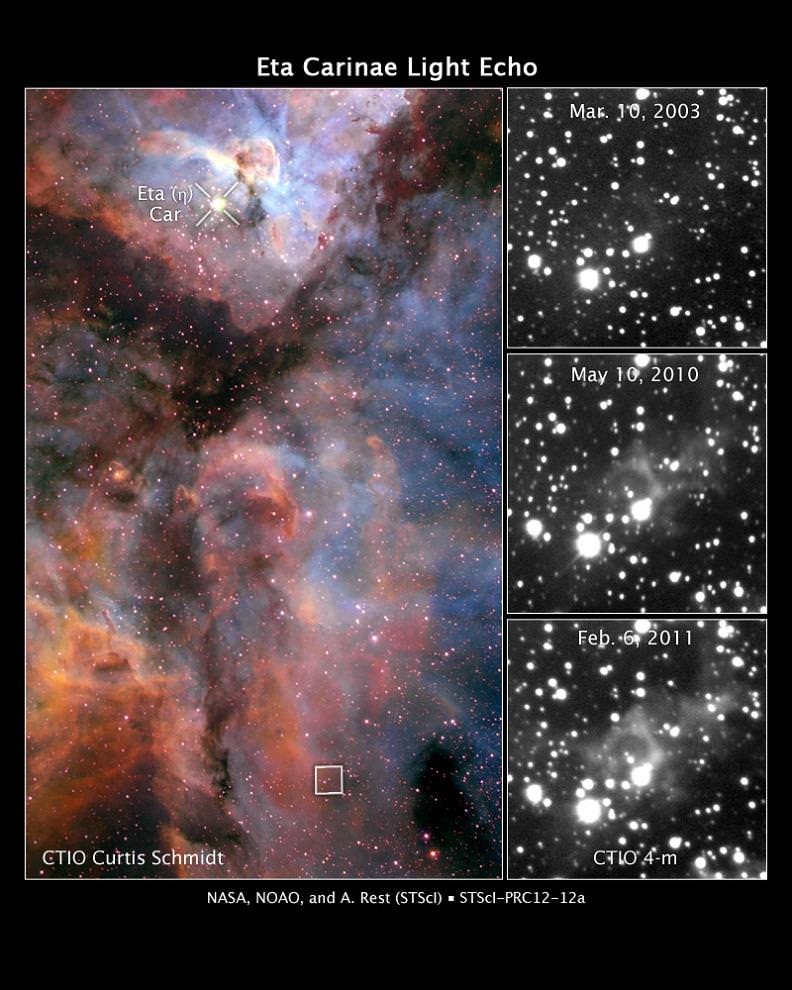[/caption]
In this modern age, we’re used to catching a favorite program at a later time. We use our DVR equipment and, not so long ago, a VCR to record now and watch later. Once upon a great time ago we relied upon a quaint customer called the “re-run” – the same program broadcast at a later date. However, a re-run can’t occur when it comes to astronomy event… Or can it? Oh, you’re gonna’ love this!
Way back in 1837, Eta Carinae had an event they called the “Great Eruption”. It was an outburst so powerful that it was observable in the southern night sky for 21 years. While it could be seen, sketched and recorded for astronomy posterity, one thing didn’t happen – and that was study with modern scientific instruments. But this great double star was about to do an even greater double-take as the light from the eruption continued away from Earth and on towards some dust clouds. Now, 170 years later, the “Great Eruption” has returned to us again in an effect known as a light echo. Because of its longer path, this re-run only took 17 decades to play again!
“When the eruption was seen on Earth 170 years ago, there were no cameras capable of recording the event,” explained the study’s leader, Armin Rest of the Space Telescope Science Institute in Baltimore, Maryland. “Everything astronomers have known to date about Eta Carinae’s outburst is from eyewitness accounts. Modern observations with science instruments were made years after the eruption actually happened. It’s as if nature has left behind a surveillance tape of the event, which we are now just beginning to watch. We can trace it year by year to see how the outburst changed.”
As one of the largest and brightest systems in the Milky Way, Eta Carinae is at home some 7,500 light years from Earth. During the outburst, it shed around one solar mass for every 20 years it was active and it became the second brightest star in the sky. During that time, its signature twin lobes formed. Being able to study an event like this would help us greatly understand the lives of powerful, massive stars on the eve of destruction. Because it is so close, Eta has also been prime candidate for spectroscopic studies, giving us insight on its behavior, including the temperature and speed of the ejected material.
But there’s more…
Eta Carinae could possibly be considered more famous for its “misbehavior”. Unlike stars of its class, Eta is more of a Luminous Blue Variable – an uber bright star known for periodic outbursts. The temperature of the outflow from Eta Carinae’s central region, for example, is about 8,500 degrees Fahrenheit (5,000 Kelvin), which is much cooler than that of other erupting stars. “This star really seems to be an oddball,” Rest said. “Now we have to go back to the models and see what has to change to actually produce what we are measuring.”
Through the eyes of the U.S. National Optical Astronomy Observatory’s Blanco 4-meter telescope at the Cerro Tololo Inter-American Observatory (CTIO) in Chile, Rest and the team first spotted the light echo in 2010 and then again in 2011 while comparing visible light observations. From there he quickly compared it with another set of CTIO observations taken in 2003 by astronomer Nathan Smith of the University of Arizona in Tucson and pieced together the 20 year old puzzle. What he saw was nothing short of amazing…
“I was jumping up and down when I saw the light echo,” said Rest, who has studied light echoes from powerful supernova blasts. “I didn’t expect to see Eta Carinae’s light echo because the eruption was so much fainter than a supernova explosion. We knew it probably wasn’t material moving through space. To see something this close move across space would take decades of observations. We, however, saw the movement over a year’s time. That’s why we thought it was probably a light echo.”
While the images would appear to move with time, this is only an “optical illusion” as each parcel of light information arrives at a different time. Follow up observations include more spectroscopy pinpointing the outflow’s speed and temperature – where ejected material was clocked at speed of roughly 445,000 miles an hour (more than 700,000 kilometers an hour) – a speed which matched computer modeling predictions. Rest’s group also cataloged changes in the light echo intensity using the Las Cumbres Observatory Global Telescope Network’s Faulkes Telescope South in Siding Spring, Australia. Their results were then compared the historic measurements during the actual event and the peak brightness findings matched!
You can bet the team is continuing to monitor this re-run very closely. “We should see brightening again in six months from another increase in light that was seen in 1844,” Rest said. “We hope to capture light from the outburst coming from different directions so that we can get a complete picture of the eruption.”
Original Story Source: HubbleSite News Release. For Further Reading: Nature Science Paper by A. Rest et al.


i wonder if the measurement of the progression of the light across the dust could be used to get a more precise measurement of the distance to eta C?